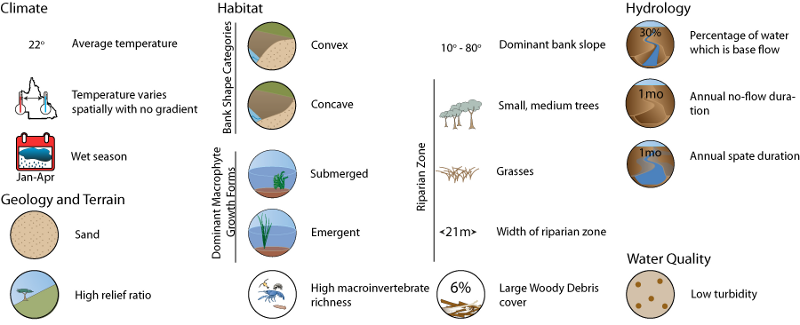|
|
Wet Tropics Freshwater Biogeographic ProvinceWet Tropics Freshwater Biogeographic Province – Geology and topography  Click on elements of the model or select from the tabs below TerrainMost of the Wet Tropics FBP has a high relief ratio, with a mean for the FBP of 0.06. Low relief ratio values are confined to small patches within the FBP, particularly the western (Atherton Tablelands) part and the mouth of the Herbert catchment and the south eastern part of the Jeannie catchment. Stream segment slope values throughout the FBP are also on average very high, with lower values corresponding to areas with low relief ratio values. The generally steep relief and high stream slopes results in steeper catchments where run-off is generally faster, producing more peaked discharges and greater erosive power[1]. This contributes to high disturbance intensity of spates in the FBP. The FBP is strongly dominated by the erosional flatness index class. Only a small proportion of the FBP contains valley bottom flat areas (in the areas with low relief ratio), and ridge top flat is almost absent. The dominance of erosional areas and steep relief is likely to result in the prevalence of coarse bed material in Wet Tropics streams and implies a dominance of aquatic assemblages preferring coarser substrate types at the FBP scale. Any biota preferring depositional areas are likely to be restricted in this FBP. The limited extent of valley bottom flats suggests floodplains and the processes associated with floodplain inundation are not likely to be important to the ecology of Wet Tropics rivers. In depositional areas turbidity typically limits light penetration and prevents the occurrence of submerged macrophytes as well as limiting benthic production to the euphotic margins. The scarcity of depositional areas in the Wet Tropics FBP is likely to be associated with the relatively low turbidity of the area and subsequently the widespread distribution of submerged macrophytes.
References
Last updated: 22 March 2013 This page should be cited as: Department of Environment, Science and Innovation, Queensland (2013) Wet Tropics Freshwater Biogeographic Province – Geology and topography, WetlandInfo website, accessed 18 March 2024. Available at: https://wetlandinfo.des.qld.gov.au/wetlands/ecology/aquatic-ecosystems-natural/riverine/freshwater-biogeo/wet-tropics/geology-topography.html |

 — Department of Environment, Science and Innovation
— Department of Environment, Science and Innovation

